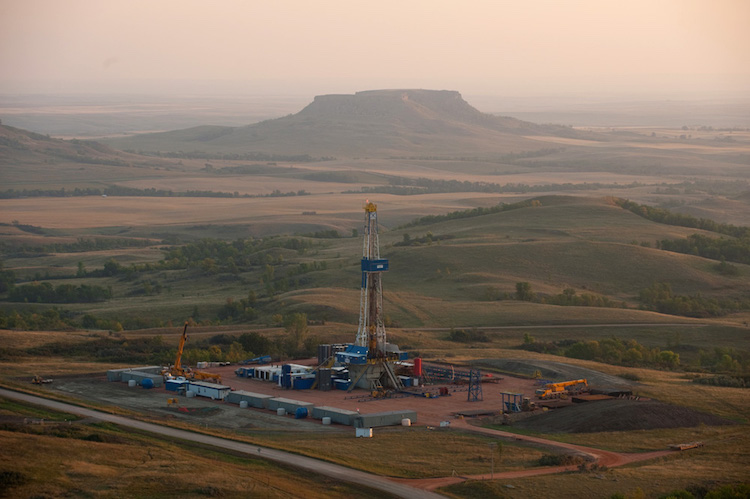Fracking Radiation
National news coverage of the scandalous illegal dumping of radioactive filter “socks” there — on Indian Reservations no less — has led North Dakota’s legislature to consider changes to its radioactive waste laws so that fracking’s contaminated wastes can be dumped in ordinary landfills.
One current bill would permit fracking’s radioactive waste in state landfills to be contaminated with 10 times the radioactivity that state law now allows — as long as it’s covered with 10 feet of dirt. Radioactive fracking waste that’s not being illegally discarded — no Victoria, mobster dumping probably hasn’t ended — is supposed to be being trucked out of state.
ND House Bills 1113 and 1114 — reportedly requested by the State Health Department — are being contested by some law makers and journalists who question the right of the department to set its own rules.
The ND Newspaper Association and the ND Broadcasters Association complained that one bill eliminates mandatory public hearings about landfill rule changes and instead permits them “when appropriate.” The bill also cancels public notification of the permitting process for disposition of radioactive materials.
Dave Glatt of the State Health Department told the Bismarck Tribunethat his agency commissioned Argon National Laboratory in Chicago to study the issue and make recommendations. The department wanted to know “radiation limits that would be safe for workers and the public.” Glatt forgets that there are no safe radiation doses, only legally permitted ones.
Locals are Worried
“We don’t want to have, when this oil and coal is gone, nothing left here, a wasteland, and I’m afraid that’s what might happen,” said Underwood farmer Gene Wirtz to KXNET news reporter Ben Smith in January. Wirtz is worried about the increased radioactivity in local landfills. “Any amount of radiation beyond what you’re already getting is not a good thing,” he said.
Radioactive isotopes that contaminate fracking industry waste and its machinery include radon, radium-226, uranium-238, and thorium-232. According to the Health Department’s website, these long-lived radioactive pollutants come in six forms:
* “Produced water” which is injected underground but later brought to the surface as waste;
* “Sulfate scales,” which are hard, insoluble deposits that accumulate on frack sand and inside drilling and processing equipment;
* Contaminated soil and machinery;
* Filter socks, contaminated by filtering “produced water”;
* Synthetic “proppants” or sand; and
* Sludge and “filter cake” solids of mud, sand, scale and rust that precipitate or are filtered out of contaminated “produced water. They build up in “filter socks,” and in waste water pipes and storage tanks that can leak.
A case in point came Jan. 6, 2015, when three-million gallons of waste water sprang from a North Dakota pipeline rupture, in Williams County north of Williston, the biggest ever in the current Bakken oil rush. Attempted containment of the leak was underway January 23 as berms were set up across Blacktail Creek to prevent the waste water from flowing into the Missouri River. The New York Times reported that the leaked waste water “may contain residue from hydraulic fracturing.”
Forbes-online Calls Potential for Harm “No Problem”
Writing Jan. 26 in Forbes online, James Conca turned upside-down the results of a recent Pennsylvania study of the risks of radiation exposure from gas fracking wastes. Mr. Conca’s column was headed, “Radiation from Fracking? No Problemo.”
The Penn. Department of Environmental Protection studied so-called “Technologically-Enhanced Naturally-Occurring Radioactive Material” or TENORM, and analyzed the levels of radioactivity associated with oil and gas extraction in the state.
Mr. Conca wrote that the PDEP study found there is “no concern of radiation exposure from fracking wells for oil or gas.
But on the contrary, the PDEP found explicitly warns of increased radiation risk from various aspects of fracking.
In particular, the PDEP report warned of:
* Limited potential for radiation exposure to the public and workers from the development, completion, production, transmission, processing, storage, and end use of natural gas;
* Potential radiological environmental impacts from fluids if spilled; and
* Little potential for radiation exposure to the public and workers from landfills receiving waste from the oil and gas industry.
* The PDEP report said there was a need for further study of the impacts of radiation from the use of “brine” or “saltwater” or so-called “produced water” from the industry since some of it is now being spread around for” dust suppression” and “road stabilization.”
Forbes trivialized and denied Pennsylvania’s formal warning, but it did say this: “With 15 million Americans living within a mile from a fracking well, this is an important result.”
John LaForge works for Nukewatch a nuclear watchdog and anti-war group in Wisconsin and edits its Quarterly newsletter.


